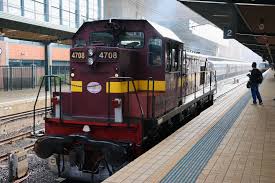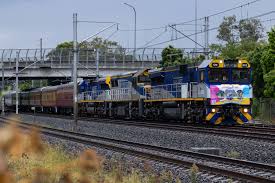A nostalgic diesel train ride through Portugal

Lisbon: The country’s only remaining narrow-gauge railway line plays host to heritage trains, offering travellers a chance to travel through the stunning Vouga Valley in a period locomotive.
We’re gathering speed as we rumble east from Portugal’s coastal city of Aveiro. Modern apartment blocks outside the train’s open windows yield to ivy-covered trees, then pastel-hued farmhouses dotted among lush green fields. The refreshing scent of eucalyptus replaces the faint diesel fug in the carriage – resplendent with hardwood benches and drop sash windows – and the conductor sounds the air horn at the townspeople waving from their terraces, gardens and balconies, thrilled to spot us.
The Vouga Historical Train runs Saturdays in July and August, departing from Aveiro at 13:45 and returning from Vouga at 20:07. Tickets cost €41 (£35) and €25 (£21) for children. Dates for the festive steam train service, which runs from late November to early January, are announced each autumn.

Why such an enthusiastic welcome? Because this isn’t just any train. This is the Vouga Historical Train, a vintage locomotive that runs through the verdant Vouga Valley on Portugal’s only remaining narrow-gauge railway. Comprised of a navy-blue 1964 Basque Railway diesel locomotive and five early 20th-Century carriages, “the Vouginha” – as it is affectionately known by locals – is a beloved summer visitor, trundling along a twisting 46km stretch from Aveiro to Macinhata do Vouga and back as part of a six-hour excursion that also includes a visit to the artsy city of Águeda. Each summer, locals and travellers alike can climb aboard for a unique railway journey into the past.
Constructed between 1907 and 1914, the Vouga line originally consisted of three branches, extending 96km north to the city of Espinho and 140km east to Viseu, with the town of Sernada do Vouga acting as a central hub.
“This series [CP 9000] of locomotives were working in the mines of Spain, then Portugal bought three or four of them,” says driver Pedro Cabelo, who has worked for national rail firm Comboios de Portugal since 2008. “The Vouga line was originally for people to travel between the cities in the interior land.”
At 668mm narrower than standard Iberian-gauge railways, the metre-wide tracks that twist and turn through the valley’s famous forests and bridges were cheaper and better suited to the winding routes when they were first laid, but eventually became economically unviable due to maintenance costs and limited capacity. Passenger services declined and ceased entirely by 1990.

But starting in 2009, sections of the track were converted into ecotrails for cycling, running and hiking, culminating with the 2023 unveiling of the Ecopista do Val do Vouga, a path/trail that completed the 80km route between the towns of Sernada and Viseu, incorporating oak and pine forests, historic stations, atmospheric tunnels and beautiful bridges.
The Vouga Historical Train debuted in summer 2017 and was an instant hit, running at full capacity during the first season. The tourism initiative was meant to launch with a steam train, but two weeks before the inaugural journey, a deadly wildfire swept through nearby Pedrógão Grande, caused in part by sparks from electrical discharges from high-voltage lines and spread by extreme summer heat. Comboios Portugal didn’t want to risk having a coal-fired train on the track, so a diesel train was drafted in for the summer series, with the steam locomotive unveiled in November for the festive edition.
Arriving 45 minutes before my train is due to depart, I find the platform already buzzing. Conductor Cabelo – dressed in a navy uniform and red neckerchief, a nod to steam-era attire – is showing passengers how he drives the train from his perch high up in the locomotive, and families are posing for photos alongside the wooden carriages.
I board along with around 200 eager passengers, marvelling at the splendidly restored heritage train. It consists of two Portuguese carriages from 1908 and 1913, a Belgian carriage from 1908, a German carriage from 1925 and an Italian carriage, all of which once ran on narrow-gauge lines and have since been restored by Comboios de Portugal. Three of the colourful wooden carriages – painted in glossy red, hunter green and royal blue, with mint green interiors and varnished dark wood seats – feature tail verandas open-air platforms that allowed passengers to enjoy the breeze during their journey.
I find a spot on one of them to take in the sweeping views of farmland and the Serra do Arestal mountains in the distance. We break occasionally at rural stations so the train’s engineer can check the temperature of the wheels to make sure they’re not overheating.
Our first proper stop is the parish of Macinhata do Vouga, where a 10-piece folk band in regional dress greets us with a jaunty tune. Spanning three generations of the same family, the singers and musicians brandish accordions and ukuleles, while percussion comes courtesy of drums, a triangle and a pair of pinecones rhythmically scraped against each other.
As we descend for a two-hour break, each passenger is handed a pastel de Águeda – a traditional golden-brown pastry stuffed with almond-flavoured filling – and taken on a 30-minute guided tour of the Macinhata do Vouga Railway Museum, located in the station’s former coach house.
“All of the locomotives we have here in Macinhata are German,” says Bernadette Silva, a volunteer guide who leads our group around the museum. “After the First World War, Germany had a debt to Portugal [that they couldn’t pay], so [dictator António de Oliveira] Salazar told them, ‘If you don’t have money to pay, you pay me with machines.'”
Another carriage, she points out, only has first- and third-class seating, because Salazar – who was prime minister for most of the nearly 50-year right-wing dictatorship that ended in 1974 – is believed to have abolished second-class trains in the 1940s to “simplify” the system, which eventually evolved into the first and second-class structure that remains in place today.
Infirmary and mail trains show how patients and post were once transported, while a curious ceramic statue reveals an ingenious system of platform signage used in the past.
“This is our naughty boy,” Silva says at the end of the tour, gesturing to the large figurine of a smiling boy in a blue shirt and no shorts, cheekily poised to urinate. “This same naughty boy was seen at a lot of stations of the Vouga valley, but the colour of his shirt was different in each station.” She explained that some people in the rural communities didn’t know how to read at the time, so when they “looked out of the window and saw the naughty boy, they knew where they were by the colour of his shirt. It was simple, but it worked!”
Our second and final two-hour stop is in Águeda, where the railway sleepers are painted in rainbow shades and an equally colourful mural on the station wall hints at the city’s artistic cache. Launched in 2006, the AgitÁgueda Art Festival was designed to regenerate the area and “colour the city” throughout July with urban artworks, installations and performances. In 2012, hundreds of umbrellas were suspended above the city centre as part of the Umbrella Sky Project, and the installation went viral, inspiring copycat streets all over the world. Now, more than 5,000 umbrellas hang above Águeda every year from July to September. Wandering through the bustling pedestrianised area, I see that this year’s colour palette includes blue and green opaque umbrellas and clear plastic ones with yellow flower motifs that bathe the streets in a warm wash of colour.
Back on the train, golden hour has descended on the Vouga Valley and puffy white clouds pepper the early evening sky as we begin the journey back to Aveiro, cheered on once more by rural residents along the way. After this summer series has concluded, the diesel locomotive is set to come back next year. Judging by the enthusiasm of visitors and locals alike, the much-loved Voughina will be welcomed whenever it returns.





